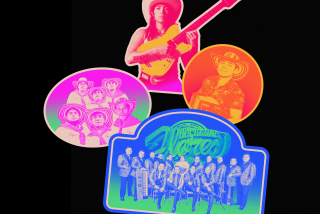Afro-Cuban Pioneer’s Brief Career Left Lingering Legacy
Cuban percussionist Chano Pozo led a musically charmed but violent life.
The muscular conga player was raised in the rough-and-tumble black slums of Havana and went on to glory in the gilded concert halls of New York. He was just 33 in 1948 when he was shot through the heart in a Harlem cafe following a dispute over a marijuana deal gone bad. But by then, Pozo had earned his place in Latin music history as the man most responsible for the fusion of Afro-Cuban drumming with modern jazz.
The life and influence of this legendary figure has been meticulously and lovingly documented in a three-CD collection recently issued by the Barcelona, Spain-based label Tumbao Cuban Classica. “Chano Pozo: The Drum of Cuba” is one of the most comprehensive and attractive collections available in the genre.
In an industry that often skimps on production quality, it’s a delight to find a set that does justice to the artistic stature of its subject. The Pozo package includes a 143-page, bilingual book footnoted like an academic paper, although the Spanish narrative reads as rapidly and dramatically as the musician’s own life. (The English translation is more stilted but still accurate.) It’s generously illustrated with historic photos and reproductions of vintage record labels.
The music selections, issued between 1939 and 1953, include Pozo’s rare early recordings on the Seeco label, available for the first time on CD. The collection also spotlights the impressive array of performers who collaborated with Pozo: Dizzy Gillespie, Tito Rodriguez, Machito, Milt Jackson, Miguelito Valdes, Arsenio Rodriguez and Bebo Valdes.
The man who put together this remarkable retrospective--both text and music--is a Catalan label executive named Jordi Pujol. The effort required years of research and record hunting, Pujol said this week from his Barcelona office. He painstakingly gathered the 69 selections, unearthing some dusty masters in a New York church and ordering other material over the Internet.
“That’s what aroused my passion, creating something that had no precedent,” says Pujol, who’s also a jazz producer. “Every time I discovered something new, it was a sensation.”
The full story of this once impoverished, untrained drummer and composer was tough to document, largely because Cuban society shunned black musicians.
“While he was alive, nobody showed any interest in interviewing him,” writes Pujol, who talked to several of Pozo’s surviving contemporaries. “Nobody thought at the time that a black without any musical education could come to be such a driving force in the development of Afro-Cuban percussion and its exciting fusion with bebop jazz.”
Luciano Pozo Gonzalez was born in 1915 in one of Havana’s crowded, dark and dangerous tenements, a solar named Pan con Timba. His father worked shining shoes; his mother died when he was 8.
The family then moved to a different solar, the Africa. There, Pozo’s father took up with the mother of another boy who would also grow up to become one of the greats of Afro-Cuban music, trumpeter Felix Chappottin. The two future musicians became as close as brothers.
Pujol describes the young Pozo as an extrovert and a charmer with a weakness for women and a penchant for fighting. His fame as a drummer and a showman grew as he appeared in Havana’s fabled comparsas, colorful processions of drummers, dancers and trumpeters that snaked through Havana representing various neighborhoods.
The solares, founded as communities of freed slaves, were also crucibles of authentic Afro-Cuban music. Pozo competed in spontaneous street drum shows, floating from solar to solar and leaving behind a trail of angry husbands and boyfriends. Later, he joined a secret male sect called abakuas , founded in 19th century Havana by descendents of Africans from Calabar.
Pozo’s professional debut came in 1938, as part of a musical review called Fiesta de Tambores . The following year, his friend and mentor, singer Miguelito Valdes, made the first recording of a Pozo composition, the classic “Blen Blen Blen.” That number kicks off the retrospective but is repeated in two versions, including one by Xavier Cugat and his Waldorf Astoria Orchestra, spurned by purists as watered-down for U.S. audiences.
Some of the old recordings have that thin and tinny sound of yesteryear, but enjoyment is enhanced by the wise use of a documentary-like narrative interspersed throughout. We hear recollections in the voices of the late Mario Bauza, a fellow Afro-Cuban jazz pioneer, and of Gillespie himself. Billy Taylor’s smooth introductions keep the story on track.
Pozo emerged as a spectacular musical figure in Havana, dressed in sparkling white from head to toe and bedecked in ostentatious jewelry. His showy persona would serve him well when he moved to New York in early 1947--not 1946, as previously believed, writes Pujol.
The volatile percussionist arrived in the U.S. with a bullet already lodged in his body, evidence of a brawl over royalty payments at the office of Cuba’s composers’ society. By Christmas of the following year, Pozo would be dead as a result of that violent showdown in Harlem.
It’s surprising to know that in fewer than 24 months, this fiery drummer had become a valued member of Gillespie’s innovative band. Although they could barely communicate, the two became a powerful creative team. One of the collection’s most revealing moments comes when Gillespie recalls the way Pozo composed “Manteca,” humming the different parts of the jazz standard as he heard them in his head.
New generations of salsa fans are bound to recognize Pozo’s riffs and refrains, which still resonate in the collective salsa subconscious. As Bauza, Machito’s band director says in his heavy accent at the start of the set:
“Sometime you’ve got to die and rest in peace for 20 years before the people start evaluating what you did. And [Chano’s] no exception to the rule. Now they want to know, because so much has happened with the conga that they want to know where that comes from. And they’ve got to go to the roots.”
More to Read
The biggest entertainment stories
Get our big stories about Hollywood, film, television, music, arts, culture and more right in your inbox as soon as they publish.
You may occasionally receive promotional content from the Los Angeles Times.










